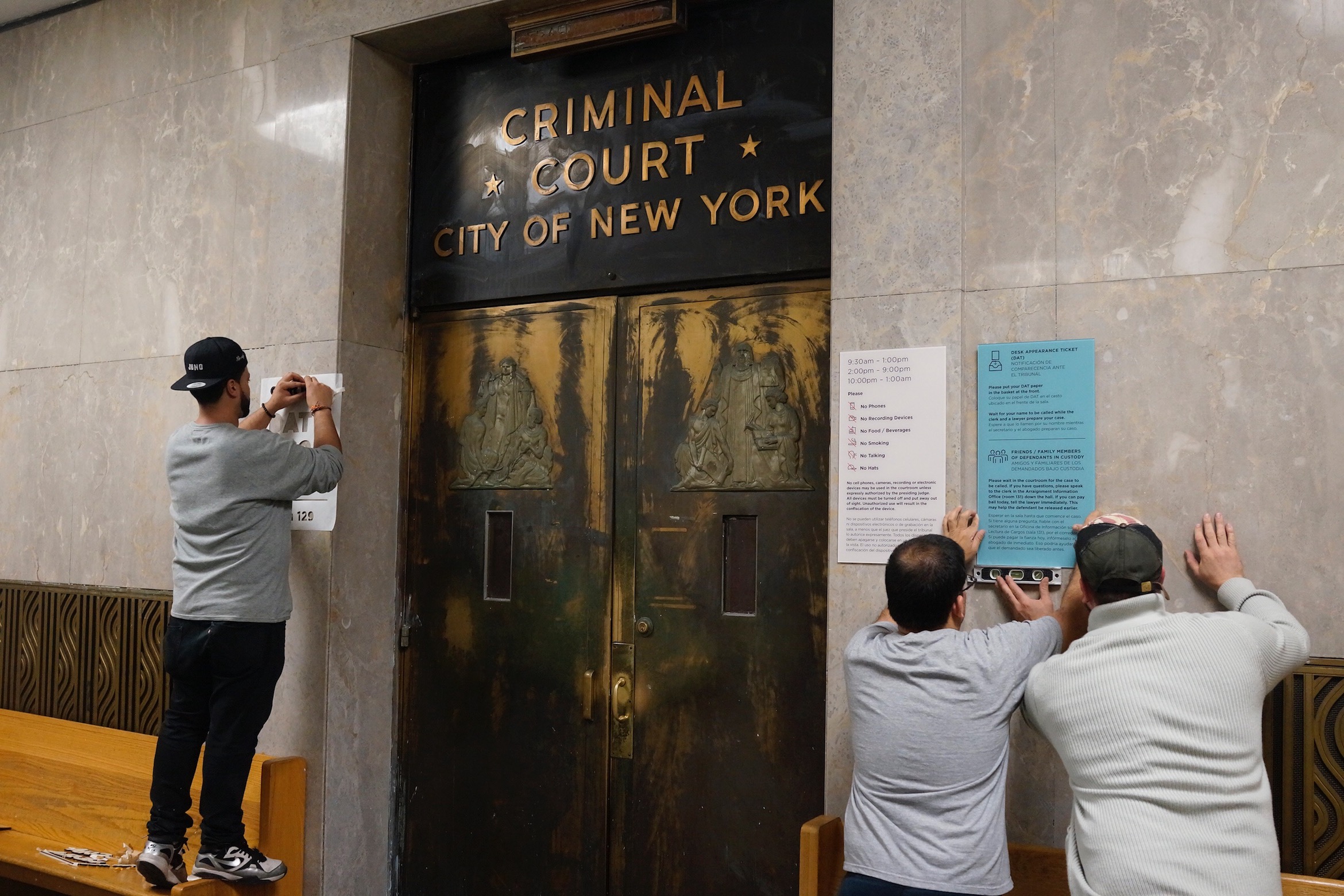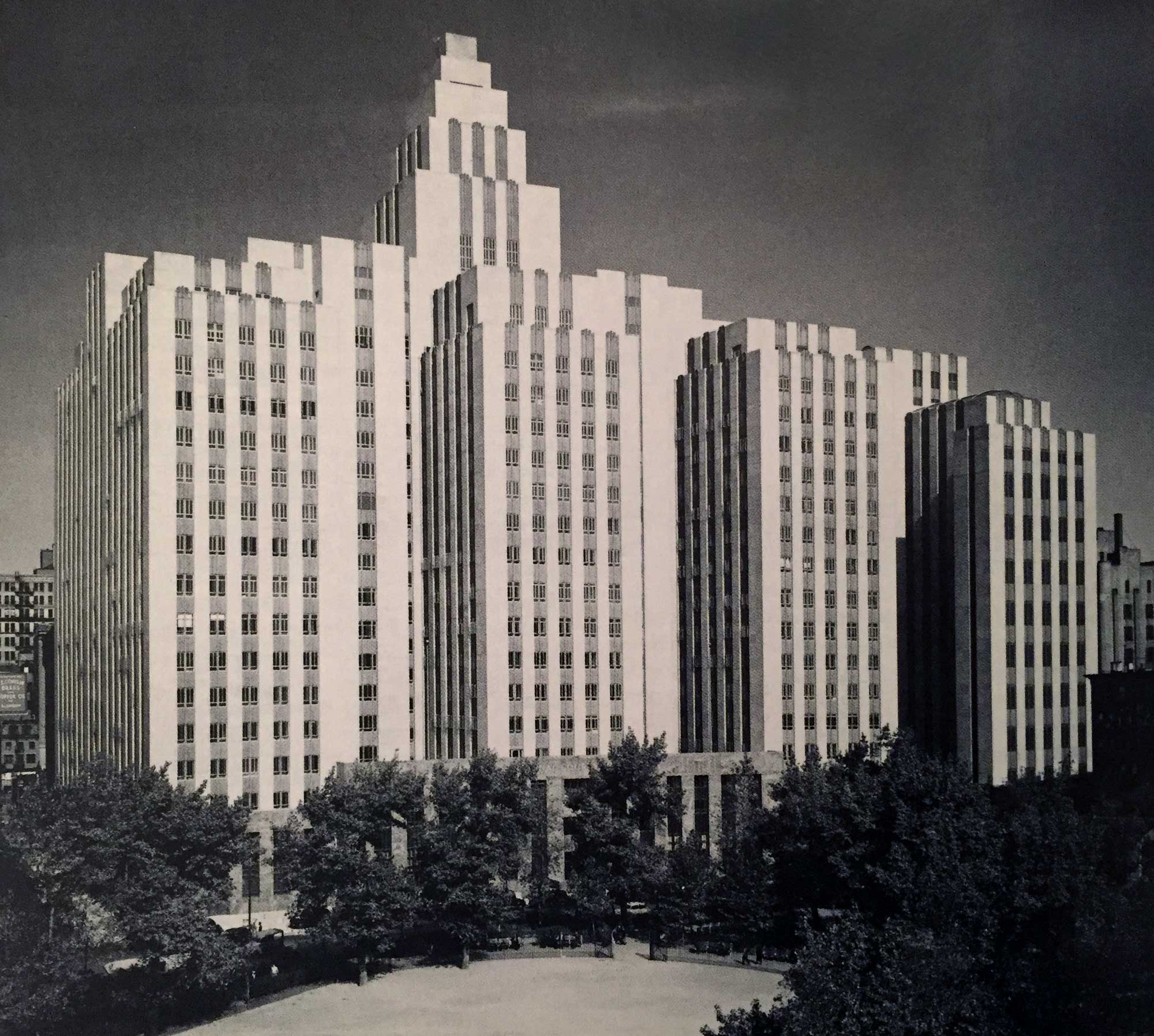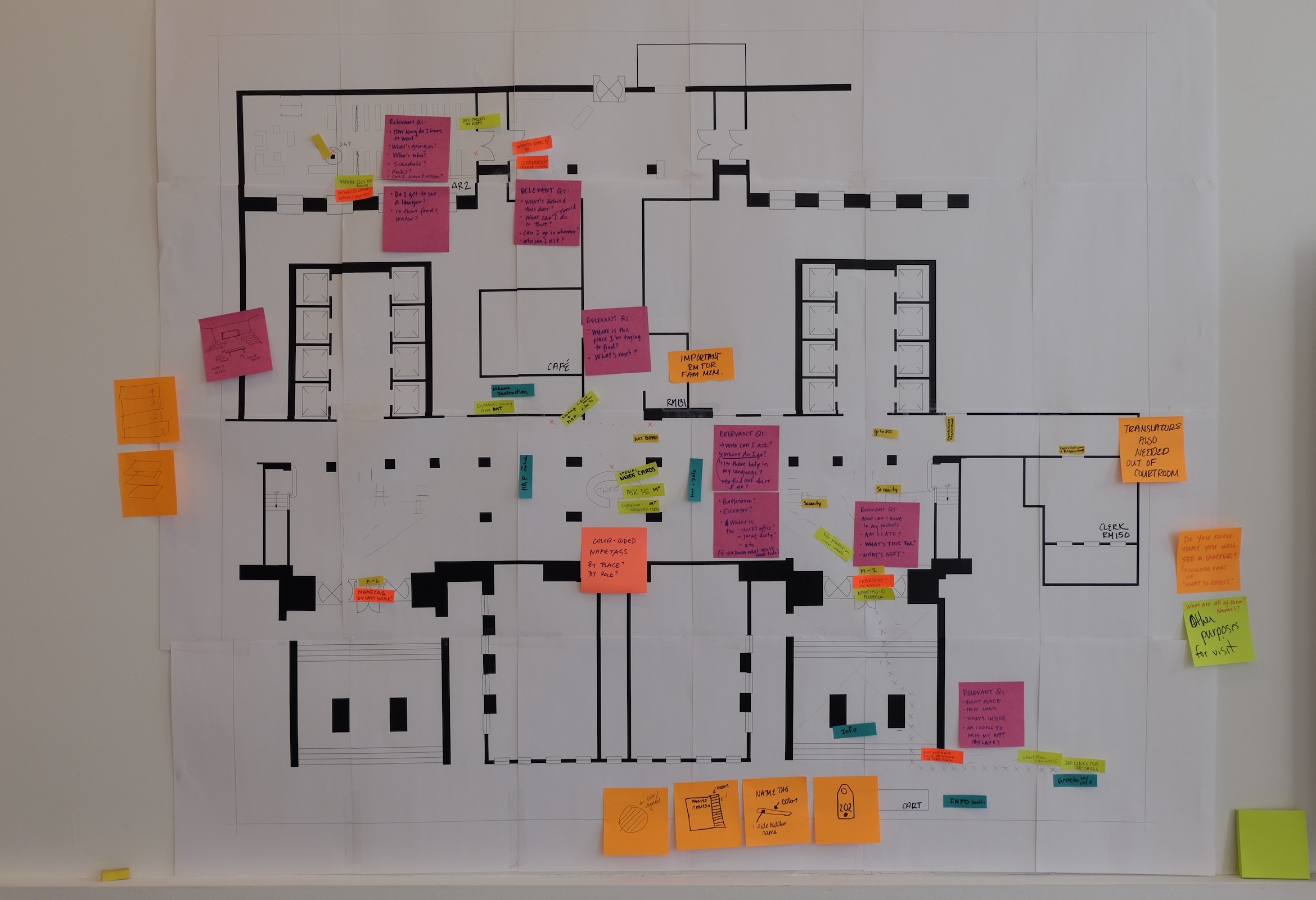The Location of Justice
An examination of the pervasive and often overlooked infrastructure of criminal justice in New York and the spaces that could serve a more just city.
In This SeriesWe are celebrating 15 years — and counting — of stories that are deeply researched and deeply felt, that build a historical record of what the city has been.
When the new Manhattan Criminal Court building at 100 Centre Street was inaugurated in 1941, one architectural critic rued that the modernist skyscraper was elusive and “uncommunicative.” Almost three-quarters of a century later, those criticisms could be leveled a thousandfold. It’s not the façade; the spaces and processes housed inside the seventeen-story building can be inscrutable. The passage of time, the astronomical growth in the volume of cases handled, and new security requirements have made for an experience that is disorienting and frustrating, to say the least, for the hundreds of thousands of people who come through the doors of the court — the city’s busiest — each year.
Could criminal court be fairer? The building doesn’t bear responsibility for the policies that criminalize so many New Yorkers. But can it make the process more legible, and improve the way people are treated once they wind up in court? The Mayor’s Office of Criminal Justice (MOCJ) is “deeply interested in how design affects behavior” Director Elizabeth Glazer told UO. How the courts feel and how court officers treat people there have a big impact on people’s trust in the criminal justice system and how they behave when they interact with it. Motivation is high to make meaningful changes to the courts and the human interactions inside them, but the city can’t start from scratch. After exploring every corner of Manhattan Criminal Court, the Center for Court Innovation (CCI), working with the strategy and graphic design studio Zago, are testing improvements to the way the building’s entrance, hallways and courtrooms work. Is designing new signage tantamount to a redesign of the justice system? No, but the smaller difference that can be made in the court experience could have ripple effects for criminal justice outcomes, and the city’s civic fabric. Below, Emily Gold-LaGratta of CCI, Justin Barry of the New York City Criminal Court, and Manuel Toscano of Zago discuss their experiment in progress.
The concept of the user experience is pretty intuitive, particularly in other industries or sectors. The Center for Court Innovation came to this topic based on research into an idea called procedural justice, which puts a lot of social science behind that intuition. Numerous studies have shown that when you focus on building trust with the public, you can not only change their perceptions, but you can change their behavior. We wanted to see if we could test that science in a pretty tough environment — a busy criminal court — looking at how to implement and enhance procedural justice principles and measure the effectiveness of those interventions.
The whole procedural justice mission is: if you think you’re getting a fair deal, and you’re being treated with respect, then your perception of the criminal justice system will be raised. You’re more likely to comply with the orders of the court. You’re hopefully less likely to commit crimes again. So with that in mind, we are looking to change, in certain ways, the way that we interact with people.
The Manhattan Criminal Court is one of the busiest courts in the country, and one where, to put it lightly, design has not been a priority.
The building was designed in the 1940s for a different volume, and a different time, when we weren’t as security-conscious. We have over 100,000 filings a year in Manhattan Criminal Court alone. Each filing is a person who’s been charged with some kind of offense. And along with that defendant who’s been charged with an offense come lawyers, DAs, victims, witnesses, jurors, all funneling into that building.
Everybody who comes into our building must go through magnetometers and have their possessions put through an X-ray machine. How do you manage that? And then, once you get into the building, where do you go? How do keep people moving through the building?
There’s been a lot of rearranging over the years. We’ve retrofitted lots of things into that courthouse that it was never designed for.
A significant part of this project was to step back and take a look at how people are using the courthouse. It’s an anxiety-producing visit for everybody, whether a defendant who has been charged with a crime and is facing possible jail time, or a victim of a crime who might have to face the person who did something to them. A juror who has no idea what’s going on. Witnesses. The only people who are comfortable, maybe, are the people who work there. So how do you redesign it, and give people more information to reduce that anxiety, and possibly reap the benefits of procedural justice?
So often the lack of information is not for lack of trying; the things that the court personnel might be trying to articulate are really complicated processes with lots of variables influencing them. Take, for example, a defendant sitting in court, wondering when their case will be called. There’s no easy answer to why he’s waiting. Maybe his attorney is late. Maybe the prosecutor is waiting on paperwork. Maybe the court staff don’t know he’s there, or he could even be waiting in the wrong courtroom. A countdown clock could never address all of those variables.
You can’t get a ticket like you do at the DMV, and sit and be told that you’re going to be the next person after that person. It just doesn’t work that way.
With this project, we were trying to do two things: make the processes that exist clearer, and also make transparent and explain processes that you may not see, but that would be helpful to understand because they impact you. How can we reduce anxiety in the absence of a clear picture? Or how can we at least make people comfortable as they’re waiting?
The Center for Court Innovation has worked with jurisdictions around the country to help them assess the presence of procedural justice practices. So we came with our method, of talking to stakeholders, meeting people who work in the building, people who experience the building. And looking for physical factors, things that are cues about access and fairness, like a handicap-accessibility ramp.
This was not our first project with the Center for Court Innovation. But the challenge here was much greater. The first question was how to translate the tenets of procedural justice and CCI’s methodology to the actual design. And then, how do we affect the physical space in such a way that it can support two things: the flow of individuals within a structure for a particular usage, and rebuilding the civic fabric?
We met with and shadowed individuals from all aspects of the criminal court process — including judges, court clerks, leadership at the relevant prosecutor and defender agencies, and court officers. We also spent hours in court to understand how current processes worked and flagged where users seemed to have questions, get frustrated, or experience other pain points. The research team also conducted their own procedures, including structured courtroom observation, defendant interviews, and a user focus group to attract people who didn’t necessarily have an active case, but had recently used the building for one reason or another, to get their feedback. The user’s perspective is critical, and there’s no substitute for it. Unfortunately, as you might imagine, it was challenging to get a significant number of people to meet with us in their free time to talk about their court experience.
The interviews with the stakeholders really brought out our empathy with anybody who had to be in the courtroom, whether defendants or people who worked in the system.
The project brings a lot of frustration to the surface for everybody involved. Not because people don’t want to make the experience better for everybody, but because the complexity of the system is such that it’s very difficult to actually intervene. There are a lot of stakeholders and there are a lot of monitors. There are a lot of decision makers. We understood that you cannot blame anybody or anything in particular for the experience. So, it’s a question of changing how people work together.
We had relatively modest expectations about what we’d be able to achieve, given our budget and our timeline. Few of the challenges we identified lend themselves to particularly easy fixes. We set out to make modest improvements to the wayfinding system and the information that court users have when they’re sitting in the courtroom.
And then we addressed some more subtle things about the cleanliness and the maintenance of the building. Little things, like polishing the floors that maybe hadn’t been polished in some number of years, or washing the windows that serve as a barrier between a clerk and the public. Really, where we thought we could make the biggest difference wasn’t in design but rather in human interaction. Those changes don’t cost a dime – but they do require buy-in and a willingness to divert from the status quo.
It’s a beautiful building. We needed to make sure that the signage was both respectful to the building but also accessible, easy to read, and friendly, without losing the importance of the place.
I kept on bringing up the word decorum. There is a tension between explaining the process, giving the users as much information as we can, and keeping in mind that we want people to know that they’re in a place that is different than a McDonald’s. It is a place that is elevated. I mean that in a figurative sense, but also in a literal sense. When you walk into the courtroom, the judge is elevated. There’s a reason why: to focus your attention on that person and also give that person a greater status. We want to encourage compliance and we also want to let people know that we have the ability to enforce our rules.
We wanted to ensure that whenever possible, we were demonstrating respect not only for individuals but for their rights. That was a big challenge, especially in the physical interventions. We wondered: Is there a way for the courthouse itself to message respect for people’s rights? How do you stress the importance of that without calling into question the very neutral function that a court needs to serve? If you’re shouting from the walls about defendants’ rights but there are victims sitting in the audience, and we were silent on victims’ rights, that’s a conflict.
We tried to think about how the physical space can supplement the messaging that we hope the people who work there are also communicating. Signs can increase the odds that a defendant feels that the system is respectful of their rights and truly wants them to understand.
It’s about the experience and the interaction between the individuals, and the sign is only there to support interactions that we are working on.
There’s another component, which is how the judges and the staff will be interacting with members of the public, and with defendants, in certain courtrooms, which will differ from what is done in other courtrooms in the building. That will involve an introduction from the judge and different introductory remarks from the court staff, with the goal of giving more information and the thought that more information reduces anxiety and creates a more relaxed and enlightened member of the public.
CCI’s research team designed a rigorous research plan to measure whether all of this amounts to improved perceptions of fairness. First, there’s a baseline stage where, before any changes were made, researchers observed court and interviewed defendants. Then, some physical changes were made in the building.
Everybody entering the building experiences some of the changes that we made, from the security process to the information desk in the lobby to the improved wayfinding signage. Additional interventions were applied in two select courtrooms, including signs outlining the courtroom rules and a name placard for the judge. After those changes were made, the researchers did another round of data collection.
Lastly, we implemented the behavioral component, which used a series of workshops with participating judges and court staff to outline a set of improved practices they could commit to trying during the two-month pilot. Those changes include additional announcements about the order in which cases will be called and extra efforts to explain the check-in process. Once those changes are implemented, the researchers will go back for one last round of data collection. What this research will show is whether physical changes alone had an impact, or whether — as I hypothesize — the physical changes plus the behavioral changes generated the biggest improvements in perceptions. And hopefully we’ll also be able to isolate which components packed the biggest punch, which can inform potential replication efforts.
We’d love to apply anything that’s successful to the rest of our courthouses. There are things that I’m learning just by watching what’s going on right here, and maybe I’ll be better prepared when we move onto Brooklyn Criminal Court.
We’re always mining for what we can share with the national field. There are so many courts and justice system agencies around the country that are looking to this concept as a way to cost-effectively build trust and improve compliance. There’s only so much that can be copied and pasted into new settings without doing significant local planning, but we hope we’re zeroing in on a process that will feel feasible for other courts to tackle.
Everything we did was in support of the tenets of procedural justice, and those are quite interesting from a design perspective. The idea that the experience that someone has prior to sentencing has a huge impact, on how they react to sentencing and interact with the system later on, is quite an interesting premise. Beyond just the courts, it’s relevant for every single building and every single interaction that we have as citizens, with each other and with the institutions of government. I think that too often, we don’t pay attention to that experience. And here we had an opportunity not only to pay attention, but to test it and learn from it, and hopefully we can go on to more courtrooms, and beyond the court system to redesign interactions that support a better civic fabric.
A lot of the project is common sense, too. Like making sure that the PA system that’s already installed in the courtroom is working. And checking to make sure that, of the ten speakers that you have stacked around the courtroom, all of them are on and audible by the members of the public. You walk into a building and there should be signs telling you where you go. You shouldn’t be looking around, asking, “What the hell am I supposed to do?”
On its face, procedural justice is about improving perceptions and compliance, but there’s often an even more powerful byproduct to projects like this: improvements in actual fairness. With this project, that looks like fixing the broken PA system in the courtroom so that users can hear better and replacing the plexiglass at a help desk window so that users can see the clerk. Those changes are posited to improve perceptions of fairness, but they also are about objective improvements to the operation of the justice system. I doubt anyone would dispute that improving actual fairness is worth the extra effort.
The views expressed here are those of the authors only and do not reflect the position of The Architectural League of New York.
An examination of the pervasive and often overlooked infrastructure of criminal justice in New York and the spaces that could serve a more just city.
In This Series


